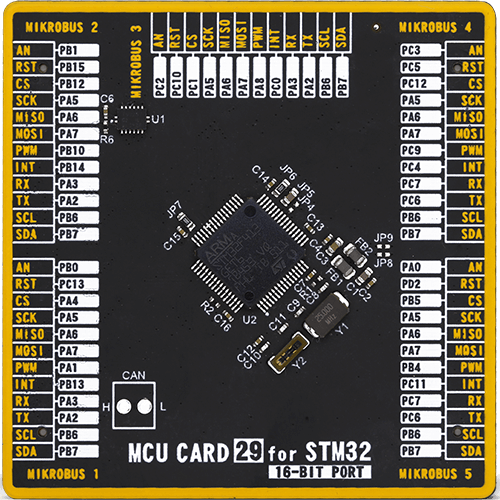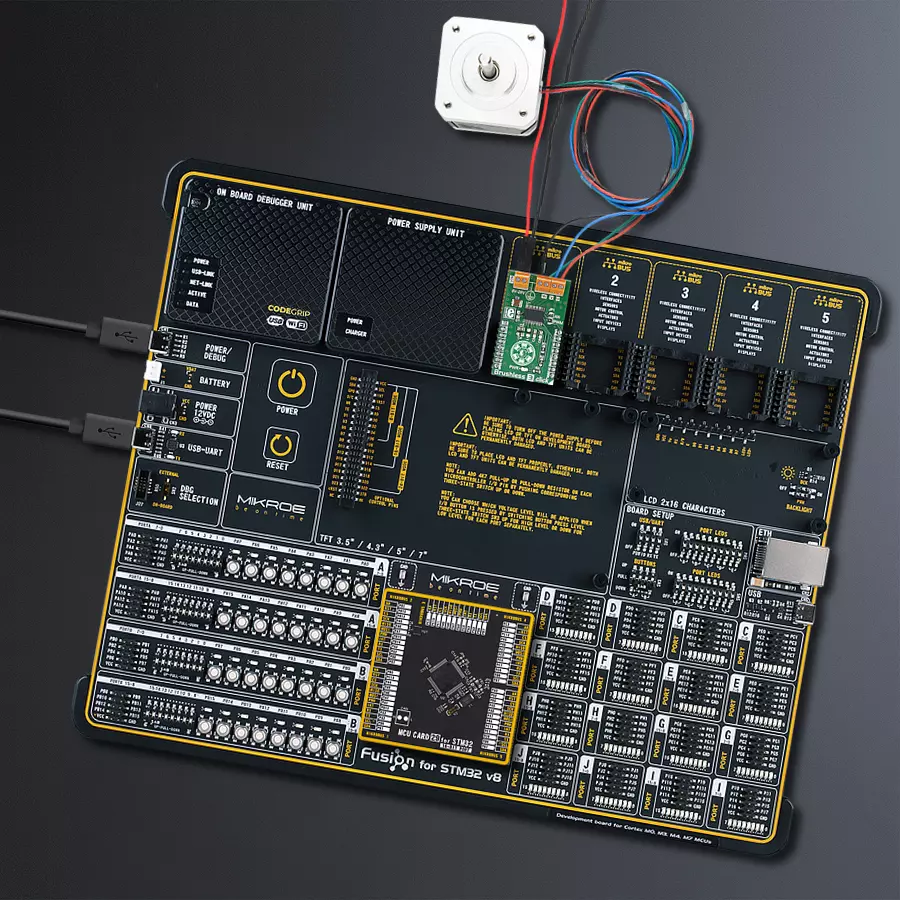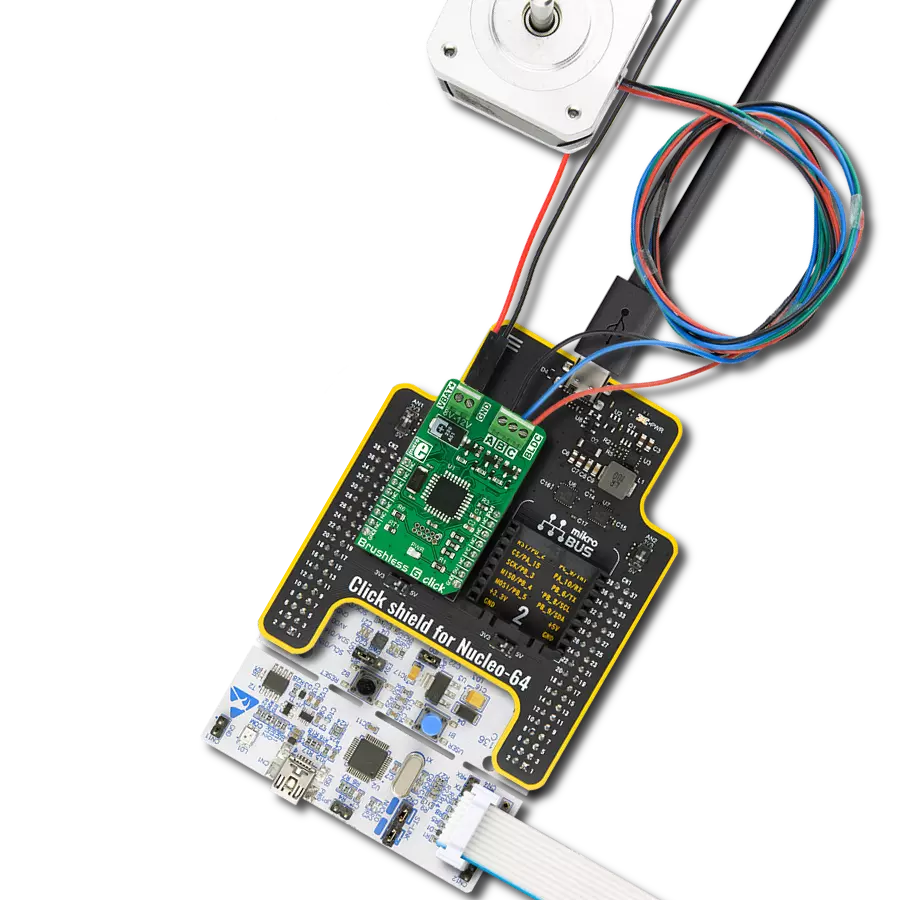Deliver precise speed and torque control, and optimize the performance of brushless motors in various applications
A
A
Hardware Overview
How does it work?
Brushless 3 Click is based on the DRV10983, a three-phase sensorless motor driver with integrated power MOSFETs from Texas Instruments. When an external power supply is applied, you can drive a brushless DC motor through the PWM pin, AN pin, or I2C interface. It communicates with the target microcontroller
over the I2C interface, with the additional functionality provided by the following pins on the mikroBUS™ line: PWM, AN, INT, and RST. The DRV10983 is a three-phase sensorless motor driver with integrated power MOSFETs, which can provide continuous drive current up to 2A. The DRV10983 uses a proprietary sensorless control
scheme to provide continuous sinusoidal drive, significantly reducing the pure tone acoustics that typically occurs due to commutation. The interface to the device is designed to be simple and flexible. The motor can be controlled directly through PWM, analog, or I2C. Motor speed feedback is available through either the FG pin or I2C.
Features overview
Development board
Fusion for STM32 v8 is a development board specially designed for the needs of rapid development of embedded applications. It supports a wide range of microcontrollers, such as different 32-bit ARM® Cortex®-M based MCUs from STMicroelectronics, regardless of their number of pins, and a broad set of unique functions, such as the first-ever embedded debugger/programmer over WiFi. The development board is well organized and designed so that the end-user has all the necessary elements, such as switches, buttons, indicators, connectors, and others, in one place. Thanks to innovative manufacturing technology, Fusion for STM32 v8 provides a fluid and immersive working experience, allowing
access anywhere and under any circumstances at any time. Each part of the Fusion for STM32 v8 development board contains the components necessary for the most efficient operation of the same board. An advanced integrated CODEGRIP programmer/debugger module offers many valuable programming/debugging options, including support for JTAG, SWD, and SWO Trace (Single Wire Output)), and seamless integration with the Mikroe software environment. Besides, it also includes a clean and regulated power supply module for the development board. It can use a wide range of external power sources, including a battery, an external 12V power supply, and a power source via the USB Type-C (USB-C) connector.
Communication options such as USB-UART, USB HOST/DEVICE, CAN (on the MCU card, if supported), and Ethernet is also included. In addition, it also has the well-established mikroBUS™ standard, a standardized socket for the MCU card (SiBRAIN standard), and two display options for the TFT board line of products and character-based LCD. Fusion for STM32 v8 is an integral part of the Mikroe ecosystem for rapid development. Natively supported by Mikroe software tools, it covers many aspects of prototyping and development thanks to a considerable number of different Click boards™ (over a thousand boards), the number of which is growing every day.
Microcontroller Overview
MCU Card / MCU

Type
8th Generation
Architecture
ARM Cortex-M4
MCU Memory (KB)
1536
Silicon Vendor
STMicroelectronics
Pin count
64
RAM (Bytes)
327680
You complete me!
Accessories
Brushless DC (BLDC) Motor with a Hall sensor represents a high-performance motor from the 42BLF motor series. This motor, wired in a star configuration, boasts a Hall Effect angle of 120°, ensuring precise and reliable performance. With a compact motor length of 47mm and a lightweight design tipping the scales at just 0.29kg, this BLDC motor is engineered to meet your needs. Operating flawlessly at a voltage rating of 24VDC and a speed range of 4000 ± 10% RPM, this motor offers consistent and dependable power. It excels in a normal operational temperature range from -20 to +50°C, maintaining efficiency with a rated current of 1.9A. Also, this product seamlessly integrates with all Brushless Click boards™ and those that require BLDC motors with Hall sensors.
Used MCU Pins
mikroBUS™ mapper
Take a closer look
Click board™ Schematic

Step by step
Project assembly
Track your results in real time
Application Output
1. Application Output - In Debug mode, the 'Application Output' window enables real-time data monitoring, offering direct insight into execution results. Ensure proper data display by configuring the environment correctly using the provided tutorial.

2. UART Terminal - Use the UART Terminal to monitor data transmission via a USB to UART converter, allowing direct communication between the Click board™ and your development system. Configure the baud rate and other serial settings according to your project's requirements to ensure proper functionality. For step-by-step setup instructions, refer to the provided tutorial.

3. Plot Output - The Plot feature offers a powerful way to visualize real-time sensor data, enabling trend analysis, debugging, and comparison of multiple data points. To set it up correctly, follow the provided tutorial, which includes a step-by-step example of using the Plot feature to display Click board™ readings. To use the Plot feature in your code, use the function: plot(*insert_graph_name*, variable_name);. This is a general format, and it is up to the user to replace 'insert_graph_name' with the actual graph name and 'variable_name' with the parameter to be displayed.

Software Support
Library Description
This library contains API for Brushless 3 Click driver.
Key functions:
brushless3_set_speed- Set speed functionbrushless3_get_speed- Get speed functionbrushless3_forward_direction- Set the direction of rotation in the forward direction function
Open Source
Code example
The complete application code and a ready-to-use project are available through the NECTO Studio Package Manager for direct installation in the NECTO Studio. The application code can also be found on the MIKROE GitHub account.
/*!
* \file
* \brief Brushless3 Click example
*
* # Description
* This Click has three-phase sensorless motor driver and
* with an external power supply it drives a brushless DC motor.
*
* The demo application is composed of two sections :
*
* ## Application Init
* Initialization driver enable's - I2C, set default parameter value.
*
* ## Application Task
* This is an example which demonstrates the use of Brushless 3 Click board.
* Read and display float motor frequency value from the DRV10983 sensorless
* BLDC motor driver on Brushless 3 Click board. Results are being sent to
* the Usart Terminal where you can track their changes.
*
*
* \author MikroE Team
*
*/
// ------------------------------------------------------------------- INCLUDES
#include "board.h"
#include "log.h"
#include "brushless3.h"
// ------------------------------------------------------------------ VARIABLES
static brushless3_t brushless3;
static log_t logger;
static float velocity = 0;
static int16_t speed = 0;
// ------------------------------------------------------ APPLICATION FUNCTIONS
void application_init ( void )
{
log_cfg_t log_cfg;
brushless3_cfg_t cfg;
/**
* Logger initialization.
* Default baud rate: 115200
* Default log level: LOG_LEVEL_DEBUG
* @note If USB_UART_RX and USB_UART_TX
* are defined as HAL_PIN_NC, you will
* need to define them manually for log to work.
* See @b LOG_MAP_USB_UART macro definition for detailed explanation.
*/
LOG_MAP_USB_UART( log_cfg );
log_init( &logger, &log_cfg );
log_info( &logger, "---- Application Init ----" );
// Click initialization.
brushless3_cfg_setup( &cfg );
BRUSHLESS3_MAP_MIKROBUS( cfg, MIKROBUS_1 );
brushless3_init( &brushless3, &cfg );
if ( BRUSHLESS3_ERROR == brushless3_default_cfg ( &brushless3 ) )
{
log_error( &logger, " Default configuration." );
for ( ; ; );
}
}
void application_task ( void )
{
log_printf( &logger, " acceleration \r\n" );
for ( speed = 100; speed <= BRUSHLESS3_MAX_SPEED; speed += 20 )
{
brushless3_set_speed( &brushless3, speed );
brushless3_get_speed( &brushless3, &velocity );
log_printf( &logger, " Motor frequency: %.2f Hz\r\n", velocity );
Delay_ms ( 100 );
}
log_printf( &logger, "\r\n ---------------------- \r\n" );
log_printf( &logger, " slowing down \r\n" );
for ( speed = BRUSHLESS3_MAX_SPEED; speed >= 50; speed -= 20 )
{
brushless3_set_speed( &brushless3, speed );
brushless3_get_speed( &brushless3, &velocity );
log_printf( &logger, " Motor frequency: %.2f Hz\r\n", velocity );
Delay_ms ( 100 );
}
log_printf( &logger, "-----------------------\r\n" );
Delay_ms ( 1000 );
}
int main ( void )
{
/* Do not remove this line or clock might not be set correctly. */
#ifdef PREINIT_SUPPORTED
preinit();
#endif
application_init( );
for ( ; ; )
{
application_task( );
}
return 0;
}
// ------------------------------------------------------------------------ END


































